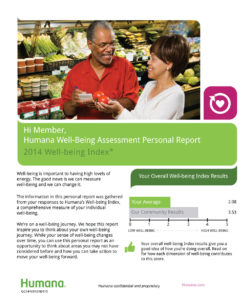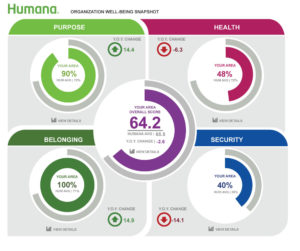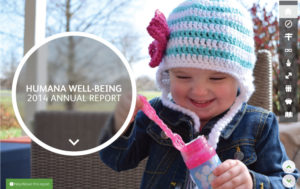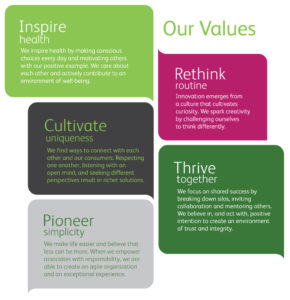 Company Background
Company Background
Over the course of 54 years, Humana has transformed the ways it brings help and care to the people it serves. As a leader in the healthcare industry, Humana has evolved from a company with the episodic customer relationships of a traditional health insurer to a company dedicated to helping people improve their health and well-being, which has become part of the company’s culture. That shared enterprise purpose came into even sharper focus last spring when Humana publically announced a goal to improve the health of the communities it serves 20 percent by 2020, by making it easy for people to achieve their best health.
Humana took the goal a step further for its internal associate community: achieve the results by the end of 2017. Humana believes that, by changing the lives of associates, the company is more able and inspired to help others do the same. Early results are promising. Since 2012, the associate community has reversed the trend toward declining health seen elsewhere in the nation1 and has seen substantial improvements in all dimensions of well-being.
Creating Impact on Well-Being through Measuring,
Communicating and Motivating Progress
 Humana’s vision for improving associate well-being is built around a social movement that connects people to the company’s purpose and one another in a way that is personally meaningful to them. This internal movement is designed to inspire, support and sustain personal transformation in all aspects of health, improve population outcomes and accelerate shared learning about what works. Among key objectives is creating a culture that stimulates action and behavior change, highlighting individual responsibility and shared commitment to one another. Humana views conversations about well-being as a critical part of its commitment to help associates be their best and live more fully. By normalizing openness around personal well-being as a way to work, conversations and connections fuel the social movement ultimately intended to make well-being easier.
Humana’s vision for improving associate well-being is built around a social movement that connects people to the company’s purpose and one another in a way that is personally meaningful to them. This internal movement is designed to inspire, support and sustain personal transformation in all aspects of health, improve population outcomes and accelerate shared learning about what works. Among key objectives is creating a culture that stimulates action and behavior change, highlighting individual responsibility and shared commitment to one another. Humana views conversations about well-being as a critical part of its commitment to help associates be their best and live more fully. By normalizing openness around personal well-being as a way to work, conversations and connections fuel the social movement ultimately intended to make well-being easier.
Humana assesses and communicates well-being through four dimensions: purpose, health, belonging and security. Having a gauge on where each associate is on his or her individual journey, as well as where people are together, are important components in bringing the movement to life. The measurement and communication on well-being takes a multifaceted approach:
- Leader and associate behaviors:
- Creating a different tomorrow requires knowing where one is today
- Talking openly normalizes different thinking about routines and support
- How the story is told:
- The journey is personal; people’s experiences matter even more than programs
- A sense of achievement is an important element of well-being
- Focused on individuals, their team and the enterprise community as a whole
- Focused on whole person well-being across the four well-being dimensions
Participation, engagement and outcome measures at the individual, team and organizational level demonstrate how programs, resources and inspirational stories come together to make lives better.
The journey toward lifelong well-being, and the actionable information that fuels it, is shared as “Yours” and “Ours.”
Your Well-Being
 Humana offers associates two types of reports for their personal health and well-being journey: a Personal Well-Being Report, which provides a holistic, self-reflected view, and a HumanaVitality® Personal Health Report, which provides a current view of individual status, actions and behaviors.
Humana offers associates two types of reports for their personal health and well-being journey: a Personal Well-Being Report, which provides a holistic, self-reflected view, and a HumanaVitality® Personal Health Report, which provides a current view of individual status, actions and behaviors.
- The Personal Well-Being Report gives associates a generalized look at their personal well-being after completing the Humana Well-Being Index® Survey.
- The Humana Well-Being Index® uses a personal perspective of well-being as a validated predictor of current and future well-being, covering the dimensions of purpose, health, belonging and security. It was developed in partnership with the University of Michigan. A score is provided for each well-being dimension. The score is an average of three areas of the dimension. For example, the overall score for health looks at how a person is doing on his or her physical, emotional and spiritual health.
- The HumanaVitality® Personal Health Report provides associates on the company health plan an overall picture of their individual health based on completion of a biometric screening and Vitality Check health assessment. The report includes a Vitality Age®, letting the associate know if he or she is living older or younger than his or her actual age based on lifestyle and habits.
Our Well-Being
Humana looks at the collective well-being journey two ways. The Organization Well-Being Snapshot provides leaders and associates with a simple online dashboard on the state of well-being within their department. The Humana Well-Being Annual Report provides everyone with a transparent and inspirational look at how the entire enterprise is moving the well-being needle. Both instruments share associates’ progress together, helping unite everyone in the effort.

- Humana’s Organization Well-Being Snapshot reports results at team levels of 250 or more associates. It compares the organization to the Humana enterprise and shows progress toward goals set around the four dimensions of well-being. Goals were established by collaborating with external and internal health and well-being subject matter experts, and most health-related goals were derived from well-publicized public health benchmarks, such as Healthy People 2020 and the CDC’s Healthy Days measure.
 The Humana Well-Being Annual Report provides an interactive, online experience of narrative, data and individual associate stories. It includes all Organization Snapshot metrics along with supplemental data points, and captures progress over multiple years toward goals.
The Humana Well-Being Annual Report provides an interactive, online experience of narrative, data and individual associate stories. It includes all Organization Snapshot metrics along with supplemental data points, and captures progress over multiple years toward goals.
- Associate Engagement Survey
- Biometric Screenings
- Internal Social Network
- Retirement Savings
- HumanaVitality® engagement
- Volunteer Network
- WOW! Working on Well-Being® Account
- And much more
Making Strides Toward Better Lives
Since inception in 2012, more and more associates have engaged in sharing their well-being journeys. The multidimensional looks have helped change the ways individuals and teams think about, talk about and do something about their well-being.
Furthermore, new cultural practices have surfaced. For example, increasingly associates share personal stories about their struggles and triumphs in living better, prompting discussion of health and well-being to be the number-one topic of internal social media, by far. Well-being has also become a regular part of team meetings. In addition, knowing the state of individual and collective well-being has triggered meaningful changes in routines that influence health. Simple things like stretching at a desk, participating in “walking meetings” and engaging in group activities supporting health are practiced more often. Also, team volunteering and enterprise step challenge participation have both increased substantially and are now well-ingrained within Humana’s culture.
This energized culture has inspired associates to live happier and healthier lives. It has helped produce real results.
- The average number of biometric risks per associate has dropped: for associates employed since 2012, four out of 10 have improved their overall health and seven out of 10 have either stayed the same or lowered their number of health risks.
- Associates who started exercising regularly in the past two years reduced their health risks by 16 percent.
- Associates who improved their health collectively lost 194,000 pounds.
- From 2012 to 2014, associates’ volunteer hours increased by 25 percent.
- Roughly 85 percent of associates actively participate in the HumanaVitality wellness platform, with 65 percent actively setting and/or achieving health goals.
- Since 2012, use of preventive health services has increased by 40 percent.
Sustaining Success
As Humana moves forward on its well-being journey, supporting associates on their individual and collective paths, CEO Bruce Broussard and other company leaders have shaped a dream into a focused destination. As Bruce recently shared, “I’m inspired by the progress we’re making toward taking better care of ourselves as a means to achieving lifelong wellbeing. What we’re doing has a big impact not only on us, but in the communities we’re a part of.” These efforts have helped spark a social movement and they nurture health and well-being in Humana’s culture in a way that can be experienced by associates and customers alike.
 Along the way, the journey is a way for every member of the team to live and experience Humana’s company values to:
Along the way, the journey is a way for every member of the team to live and experience Humana’s company values to:
- Inspire health
- Cultivate uniqueness
- Rethink routine
- Pioneer simplicity
- Thrive together
These values make the company most successful…most human…most Humana.
- Flegal KM, Carroll MD, Kit BK, Ogden CL. Prevalence of obesity and trends in the distribution of body mass index among US adults, 1999-2010. JAMA. 2012;307(5):491-497. http://jama.jamanetwork.com/article.aspx?articleid=1104933